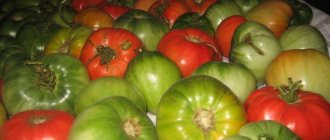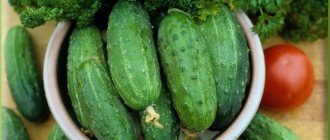https://twizz.ru/wp-content/uploads/2018/10/treea1.jpg
Watermelon is a foreign berry (or a fruit, and for some, a vegetable). It appeared on the African continent, and was brought to Russian soil in the thirteenth century. The melon culture delights everyone, young and old, with its sweetness and is often associated with hot summer days and pleasant sunny evenings.
Everyone wants to enjoy the taste of watermelons for as long as possible. The duration of storage of fresh watermelons may vary. Damaged specimens can last about two weeks, a watermelon at room temperature will remain in the desired condition for about two months, but if you follow certain storage rules and take the right variety, then after four months you can enjoy this tasty and sweet fruit.
Of course, I really want to enjoy watermelon not only in the summer, but also in the cold winter, and, preferably, not in salted form, but fresh and natural. It turns out that this is quite possible. It is enough to choose the right fruit and follow certain storage requirements. Let's tell you about everything in more detail.
Which watermelons can be stored for a long time?
Choose fruits that can preserve their appearance and taste:
- the peel must be intact, undamaged, without punctures or abnormal growths; it is recommended to take fruits with thick peel;
- the optimal weight of the fruit is 4.5 -5 kg: medium-sized watermelons are better stored;
- late-ripening varieties bred as a result of selective selection are suitable;
- the yellow stripe on the side should be of a minimum size; this mark remains in place.
Choose fruits that can preserve their appearance and taste
Important! White side spots are a sign of the presence of nitrates.
- the tail is checked for dryness before selection (a halo around the tail indicates that the fruit has ripened naturally, its absence means that it has ripened in a store or warehouse);
- when tapped, a dull sound is formed, which indicates moderate ripeness;
- the peel is shiny, with pronounced stripes: these are signs that the fruit is intact;
- The suitable period for choice is September or early October.
Interesting! The world's only black-skinned watermelon is grown in Japan. There are varieties with yellow flesh.
Varieties that are suitable for storage:
| Variety | Characteristic |
| Gift of the Sun | This species is grown in Siberia, is resistant to cold, the fruits are small and strong, ripens in 2 months, the peculiarity is the yellow color of the peel |
| Striped | The fruit has a classic appearance, dark green with clear stripes, grows up to 13 kg |
| Chill | Named because of its ability to withstand low temperatures, suitable for storage, the fruits are spherical, strong, the pulp is sugary, rich in color. |
| Astrakhan | They have a sugary taste, bright red flesh, dense, spherical |
| Maristo | This is a hybrid species, early ripening, but has the ability to be stored for a long time, the peel is thick, the fruits are strong and medium in size. |
| Volzhsky | Dark green, thick-skinned, with bright red flesh |
| Popovka | Small, dense, juicy, containing large seeds |
Read more ► How to keep grapes fresh all winter
When choosing, they are guided not only by appearance, but also by additional characteristics.
Most early-ripening varieties are unsuitable for long-term preservation, although they have memorable taste qualities.
Information! Attempts to preserve species such as “Lunarium”, “Suga Baby”, “Baraka” will not be successful due to the characteristics of the varieties.
Conditions for long-term storage
Basic storage conditions:
- darkness,
- ventilation,
- compliance with temperature conditions.
The choice of location for preservation depends on the possibility of darkness, the obstruction of sunlight or bright artificial light.
The location is chosen in advance, containers, boxes, barrels are placed in an area with open access, without the need to rearrange them.
The room must be ventilated, which ensures that the optimal temperature is maintained and does not create conditions for the growth of bacteria.
The ideal storage temperature is +2...+5 degrees Celsius. Berries freeze at a lower temperature; when it rises, fermentation processes begin to occur. The humidity level should be 65-80%. Excess moisture leads to rotting.
Storage in a house or apartment
The advantage of a private house is the presence of a basement where many canned products, potatoes, and root vegetables are stored.
The temperature in the cellar remains unchanged with proper design and compliance with operating rules. Additional storage spaces - garage, attic, dressing room, pantry.
Ideal storage temperature – +2…+5 degrees Celsius
There are no such favorable conditions in the apartment, so they are created artificially. A storage room, a balcony, and an insulated loggia are used.
Methods
Important! The main task is to prevent rotting and fermentation, so the temperature and humidity of the selected room are taken into account.
Boxes and containers intended for storage are inspected, washed if necessary, and dried under natural conditions.
Watermelons are prepared separately: to remove excess moisture from the peel, they are covered with tops for 24 hours, then wiped dry.
Moss
This is a basement storage option, since the required temperature is +2...+3 degrees Celsius. Moss is used as insulation and a material with antibacterial properties.
Preparations begin in advance. Moss is collected in the forest in established dry weather. If you collect material after rainy days, it will be wet and unsuitable for use. After collection, the moss is further dried in the sun.
The box is lined with moss over the surface area, leaving no gaps, the berries are placed, and the space between them is covered with moss to prevent contact.
The boxes are inspected periodically. If during collection you come across a damaged piece of moss, it may rot.
Hanging
The method requires special conditions. The weight of the fetus is 5 kg, this must be taken into account when choosing a design for hanging.
Read more ► How to choose and store dried fruits, wash, freeze, fight mold and insects
It is wrapped in thick fabric that does not contain synthetic fibers and wrapped in newspapers. Wax paper is suitable for packaging.
Place in a strong net and hang from a hook in the basement or pantry. When hanging, the berries do not come into contact with hard surfaces, are ventilated from all sides and do not require turning over.
Straw
The option is called “store-bought”; the fruits are often stored in straw on vegetable bases.
The containers are lined with dried straw and the watermelons are covered on all sides. The container for such storage should be wooden. Once every 2 weeks, the fruits are inspected, damaged ones are removed, and straw is added if necessary.
The option is called “store-bought”; the fruits are often stored in straw in vegetable warehouses
Before use, it is necessary to check the straw and dry it additionally, if necessary.
Ash
Ash prevents the appearance of moisture and the formation of rot. The ash is sifted through a sieve to remove large pieces. A thick layer of ash is poured into a wooden box with solid walls or into a barrel, a watermelon is placed, and the ashes are poured on top.
This method will require a lot of ashes, not everyone has the opportunity to do this, so the method is not popular.
Wax or paraffin
The processing method involves the use of a stand. The paraffin is melted in a suitable container, a layer up to 1.5 cm thick is applied with a brush. Store at +4 degrees Celsius.
Important! The optimal water temperature for storage is +15 degrees Celsius.
The wax firmly seals the surface of the watermelon, preventing pathogenic bacteria from developing there.
The layer must be airtight, otherwise nothing will work.
Water
This option is suitable for those who cannot store watermelon in the basement. The inconvenience of this method is that the water will have to be changed every 10 days. There should be no microcracks on the fruit, otherwise water will get there and the watermelon will be completely spoiled.
Important! The optimal water temperature for storage is +15 degrees Celsius.
Store the fruit in a barrel or large basin, cover the container with a lid or thick cloth.
Sand or clay
Basement storage option, usually used for root vegetables. Watermelons are also stored under the condition that they are not turned over during the entire period, and whether they have been preserved or not is unknown until the moment they are pulled out.
The sand is sifted, poured into a container, the fruits are placed, and clay is poured on top. The mixture is compacted tightly. Then the box is loosely closed.
The method involves following the rules:
- the top layer of sand or clay must remain dry;
- The berries inside the box are placed at a distance from each other so that they do not touch.
Read more ► How to properly store bananas at home so that they don’t turn black; can they be frozen?
Reviews
Many people share their experience of successfully preserving the fruit until winter.
Svetlana: “Watermelon is the highlight of my New Year’s table. I usually buy fruit for the winter at the end of September. The main thing is to choose a whole and strong one. I coat it with alabaster mixture. I dilute the solution to the consistency of sour cream. After drying, the surface should be smooth, without cracks. I hang the processed berries in a net in the basement.”
Sergey: “I always saved a watermelon for my son’s birthday in January. This has become our home tradition, and now that the child has grown up, he still comes to us for a treat. We don’t live in a private house, so we leave the watermelon on the mezzanine in a box with crumpled paper. Sometimes I coat it with wax. To do this, I melt 10 regular candles in a bowl. I hold the fruit suspended, dip it a little and turn it on each side. The wax sets immediately, especially if the berry has been in the refrigerator.”
How long do watermelons last?
Shelf life is about 4 months, provided that the recommendations are followed.
Do they ripen during storage?
The temperature for ripening the harvested fruit is +20…25 degrees Celsius. Low temperature conditions cannot promote berry ripening.
The temperature for ripening the harvested fruit is +20…25 degrees Celsius
Many people believe that an unripe fruit is better preserved, and this is true. Inside it will remain unripe, that is, exactly as it was sent for storage.
Common Mistakes
The main mistake is considered to be neglecting the rules listed above. But there are several other oversights that harm the process:
— Using glossy magazines for packaging . There is no need to do this, since printing uses chemical dyes that end up in the fruit;
— Canning in paraffin . It is a petroleum product, so it should not come into contact with food.
Is it possible to freeze watermelon before the New Year?
It is not customary to freeze whole berries: when exposed to temperatures below 0, the inside of the berry becomes covered with ice, and when defrosted, it thaws, forming excess water. This affects the taste: the watermelon becomes watery and less sweet.
Many housewives use watermelon to freeze in parts. The taste of the preparations is inferior to the real cut fruit, but there are fans of preservation.
There are several techniques:
- The pieces are cut, dried, and sent to the freezer. After the first stage of freezing, the pieces are poured into a bag and frozen completely.
- The piece is sprinkled with sugar, transferred, and frozen in a container.
- All seeds are completely removed, then the pulp is poured with any fruit juice and frozen in a plastic container for an hour.
Homemade recipes cannot recreate the taste of a real whole watermelon; they are used as ice for drinks and for decorating desserts.
Defrosting of workpieces is carried out in two stages:
- The container is taken out of the freezer and placed in the refrigerator;
- Finally defrost at room temperature.
Defrosting too quickly will deprive the watermelon of taste and the pieces will completely lose their shape.
Recommendations
According to reviews from experienced melon growers, it is recommended to adhere to the following rules for long-term storage:
1. Use only ripe watermelons. After picking, they will not ripen further, and unripe fruits are stored less and do not have a perfect taste;
2. When storing, berries should not touch each other, other vegetables or fruits;
3. Do not place watermelons on hard and hard surfaces. It is necessary to add straw, sawdust, sand, grain;
4. Fruits should be constantly turned over to ensure their integrity is maintained.
With the right choice and following all the rules, the berries are stored without loss of taste for 3-4 months.











